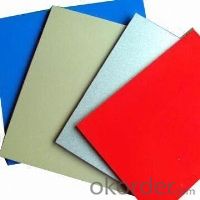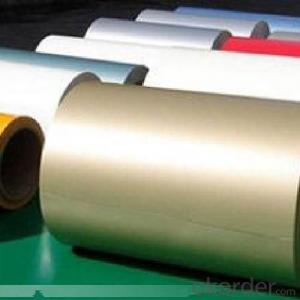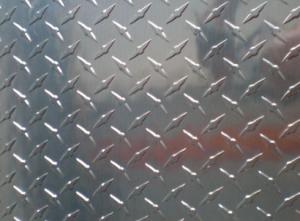Colored Anodized Aluminum Sheets - Pre Painted Alu Sheet for Different Colors
- Loading Port:
- China Main Port
- Payment Terms:
- TT OR LC
- Min Order Qty:
- -
- Supply Capability:
- -
OKorder Service Pledge
OKorder Financial Service
You Might Also Like
Aluminium alloys with a wide range of properties are used in engineering structures. Alloy systems are classified by a number system (ANSI) or by names indicating their main alloying constituents (DIN and ISO).
The strength and durability of aluminium alloys vary widely, not only as a result of the components of the specific alloy, but also as a result of heat treatments and manufacturing processes. A lack of knowledge of these aspects has from time to time led to improperly designed structures and gained aluminium a bad reputation.
One important structural limitation of aluminium alloys is their fatigue strength. Unlike steels, aluminium alloys have no well-defined fatigue limit, meaning that fatigue failure eventually occurs, under even very small cyclic loadings. This implies that engineers must assess these loads and design for a fixed life rather than an infinite life.
Another important property of aluminium alloys is their sensitivity to heat. Workshop procedures involving heating are complicated by the fact that aluminium, unlike steel, melts without first glowing red. Forming operations where a blow torch is used therefore require some expertise, since no visual signs reveal how close the material is to melting. Aluminium alloys, like all structural alloys, also are subject to internal stresses following heating operations such as welding and casting. The problem with aluminium alloys in this regard is their low melting point, which make them more susceptible to distortions from thermally induced stress relief. Controlled stress relief can be done during manufacturing by heat-treating the parts in an oven, followed by gradual cooling—in effect annealing the stresses.
The low melting point of aluminium alloys has not precluded their use in rocketry; even for use in constructing combustion chambers where gases can reach 3500 K. The Agena upper stage engine used a regeneratively cooled aluminium design for some parts of the nozzle, including the thermally critical throat region.
Another alloy of some value is aluminium bronze (Cu-Al alloy).
Aluminium foil acts as a total barrier to light and oxygen (which cause fats to oxidise or become rancid), odours and flavours, moistness, and germs, it is used broadly in food and pharmaceutical packaging. The purpose of aluminium is to make long-life packs (aseptic processing|aseptic packaging) for drinks and dairy goods, which allows storing without refrigeration. Aluminium foil containers and trays are used to bake pies and to pack takeaway meals, ready snacks and long life pet foods.
Aluminium foil is widely sold into the consumer market, often in rolls of 500 mm (20 in) width and several metres in length.It is used for wrapping food in order to preserve it, for example, when storing leftover food in a refrigerator (where it serves the additional purpose of preventing odour exchange), when taking sandwiches on a journey, or when selling some kinds of take-away or fast food. Tex-Mex restaurants in the United States, for example, typically provide take-away burritos wrapped in aluminium foil.
Aluminium foils thicker than 25 μm (1 mil) are impermeable to oxygen and water. Foils thinner than this become slightly permeable due to minute pinholes caused by the production process.
- Q: What is the typical hardness of aluminum sheets?
- The typical hardness of aluminum sheets can vary depending on the specific alloy and tempering process used, but it generally falls within the range of 40-70 on the Rockwell B scale.
- Q: I need some aluminum sheets for an art project. I'm not sure where to find such a thing, though. I've looked at Home Depot briefly and aluminum flashing is the closest thing I've found. Flashing comes in a roll and is just a bit too thin. I need flat sheets of aluminum that are somewhat stiff, but not more than, say, 1/4 thick. Are there any stores that sell such things? A larger sheet would be fine if I could either get it cut at the store or find some way to cut it to the size I want. How do you cut aluminum, anyway? Any suggestions are greatly appreciated!
- A local welding shop will have the sheets you need, and is equipped to cut it to size for you.
- Q: What specific criteria or conditions must be met when utilizing high-quality aluminum sheets in construction?
- <p>High-quality aluminum sheets used in construction projects require adherence to specific standards. They must possess high strength, corrosion resistance, and durability to withstand environmental conditions. Compliance with industry standards such as ASTM or ISO is crucial. Additionally, the sheets should be compatible with other construction materials and meet safety regulations. Proper installation techniques and qualified personnel are also essential to ensure the integrity and longevity of the construction project.</p>
- Q: What are the different surface finishes for aluminum sheets in the aerospace industry?
- In the aerospace industry, aluminum sheets are commonly used in the construction of aircraft structures due to their lightweight and high strength properties. To enhance their durability, protect against corrosion, and improve aesthetic appeal, various surface finishes can be applied to aluminum sheets. One of the most commonly used finishes is anodizing, which involves electrolytically coating the aluminum with a protective oxide layer. This process not only improves corrosion resistance but also provides a range of color options and enhances the sheet's ability to accept adhesives. Another popular finish is alclad, which involves bonding a thin layer of pure aluminum to both sides of an alloy sheet. This not only provides excellent corrosion resistance but also allows for better bonding with composite materials. In addition to anodizing and alclad, other surface finishes used in the aerospace industry include chemical conversion coatings, which provide corrosion resistance and improve paint adhesion, and mechanical finishes such as grinding or brushing, which can be used for aesthetic purposes or to prepare the surface for further treatment. Furthermore, some specialized finishes are employed for specific applications. For instance, in areas where high wear resistance is required, hard anodizing can be used to create a durable, wear-resistant surface. For parts that require low friction or high lubricity, a Teflon coating or dry film lubricant can be applied. The choice of surface finish for aluminum sheets in the aerospace industry depends on the specific requirements of the application, including factors such as corrosion resistance, adhesion properties, wear resistance, and aesthetic preferences.
- Q: How do you ensure the flatness of large aluminum sheets?
- To ensure the flatness of large aluminum sheets, several measures can be taken. First, the sheets can be carefully selected from the manufacturer to ensure they meet the required flatness standards. Second, proper storage and handling techniques should be followed to prevent any bending or warping of the sheets. Additionally, employing specialized equipment and techniques such as tension leveling or roller leveling can help flatten the sheets to the desired degree. Regular quality checks and inspections throughout the manufacturing process also play a crucial role in maintaining the flatness of aluminum sheets.
- Q: What are the acoustic properties of aluminum sheets?
- Aluminum sheets have relatively low acoustic absorption and transmission properties, making them reflect sound waves rather than absorbing or transmitting them.
- Q: Are the aluminum sheets suitable for manufacturing marine propellers?
- Yes, aluminum sheets are suitable for manufacturing marine propellers. Aluminum is a lightweight and corrosion-resistant material, making it an excellent choice for marine applications. It offers good strength-to-weight ratio, high durability, and can withstand harsh saltwater environments. Additionally, aluminum propellers are known for their efficient performance and cost-effectiveness.
- Q: How do aluminum sheets perform in terms of chemical resistance?
- Good chemical resistance properties are typically found in aluminum sheets. However, their performance may vary depending on the specific chemical environment and conditions. Aluminum is known for its excellent resistance to corrosion from most acids, alkalis, and organic solvents. It creates a protective oxide layer on its surface, preventing further reaction with numerous chemicals. Nevertheless, aluminum can corrode in certain aggressive environments, such as strong acids like hydrochloric acid or sulfuric acid, as well as alkaline solutions with high pH levels. In these instances, the protective oxide layer can deteriorate, leading to the degradation of the aluminum surface. Furthermore, localized corrosion or pitting can occur on aluminum surfaces when exposed to certain chemicals like mercury and specific salts. Therefore, it is important to consider the specific chemicals and concentrations to which the aluminum sheets will be exposed when evaluating their chemical resistance. Various surface treatments, coatings, or alloys can be applied to enhance the chemical resistance of aluminum sheets. These modifications offer additional protection against specific chemicals or environmental conditions, further improving the overall chemical resistance properties of aluminum sheets. In conclusion, aluminum sheets generally possess good chemical resistance. However, their performance can be influenced by the specific chemical environment and conditions. It is advisable to assess the compatibility of aluminum with the intended chemicals and consider appropriate surface treatments or coatings if necessary.
- Q: What type of aluminum plate does the traffic sign use? 1100?
- The aluminum alloy sheet of grade 3003 should be adopted in the road with higher technical level,The large sign board or the sign board of the coastal windy area should adopt the aluminum alloy sheet of grade 3004 or 3104.
- Q: Are the aluminum sheets available in different grades?
- Yes, aluminum sheets are available in different grades. Aluminum is commonly used in various industries due to its lightweight, corrosion resistance, and strength-to-weight ratio. Different grades of aluminum sheets are designed to meet specific requirements for various applications. The most common grades include 1100, 3003, 5052, 6061, and 7075. Each grade has its own unique properties and characteristics, such as strength, formability, weldability, and machinability. The choice of grade depends on factors such as the intended use, environmental conditions, and desired properties of the finished product.
Send your message to us
Colored Anodized Aluminum Sheets - Pre Painted Alu Sheet for Different Colors
- Loading Port:
- China Main Port
- Payment Terms:
- TT OR LC
- Min Order Qty:
- -
- Supply Capability:
- -
OKorder Service Pledge
OKorder Financial Service
Similar products
Hot products
Hot Searches
Related keywords


























